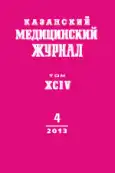Efficacy of erythropoiesis-stimulating agents and their effect on quality of life in anemic patients with lymphoproliferative diseases
- Authors: Romanenko NA1, Bessmeltsev SS1, Karmatskaya II1, Potikhonova NA1, Abdulkadyrov KM1
-
Affiliations:
- Russian Scientific and Research Institute of Hematology and Transfusiology, Saint-Petersburg, Russia
- Issue: Vol 94, No 4 (2013)
- Pages: 468-473
- Section: Theoretical and clinical medicine
- URL: https://journals.rcsi.science/kazanmedj/article/view/1951
- DOI: https://doi.org/10.17816/KMJ1951
- ID: 1951
Cite item
Full Text
Abstract
Full Text
##article.viewOnOriginalSite##About the authors
N A Romanenko
Russian Scientific and Research Institute of Hematology and Transfusiology, Saint-Petersburg, Russia
Email: rom-nik@yandex.ru
S S Bessmeltsev
Russian Scientific and Research Institute of Hematology and Transfusiology, Saint-Petersburg, Russia
I I Karmatskaya
Russian Scientific and Research Institute of Hematology and Transfusiology, Saint-Petersburg, Russia
N A Potikhonova
Russian Scientific and Research Institute of Hematology and Transfusiology, Saint-Petersburg, Russia
K M Abdulkadyrov
Russian Scientific and Research Institute of Hematology and Transfusiology, Saint-Petersburg, Russia
References
- Бессмельцев С.С., Абдулкадыров К.М. Множественная миелома. - СПб.: Диалект, 2004. - 448 с.
- Бессмельцев С.С., Гусева С.А. Современные принципы лечения анемии у пациентов с онкогематологическими заболеваниями // Укр. ж. гематол. та трансфузiол. - 2009. - №1. - С. 5-17.
- Романенко Н.А. Патогенез и терапия анемии препаратами рекомбинантного эритропоэтина у онкогематологических больных // Онкогематология. - 2012. - №3. - С. 20-29.
- Campos M.P.O., Hassan B.J., Riechelmann R., Del Giglio A. Cancer-related fatigue: a practical review // Ann. Oncol. - 2011. - Vol. 22, N 6. - P. 1273-1279.
- Cella D. The Functional Assessment of Cancer Therapy-Anemia (FACT-An) scale: a new tool for the assessment of outcomes in cancer anemia and fatigue // Semin. Hematol. - 1997. - Vol. 34. - P. 13-19.
- Christodoulou C., Dafni U., Aravantinos G. et al. Effects of epoetin-α on quality of life of cancer patients with solid tumors receiving chemotherapy // Anticanc. Res. - 2009. - Vol. 29. - P. 693-702.
- Lind M., Vernon C., Cruickshank D. et al. The level of haemoglobin in anaemic cancer patients correlates positively with quality of life // Br. J. Cancer. - 2002. - Vol. 86. - P. 1243-1249.
- Ludwig H., Van Belle S., Barrett-Lee P. et al. The European Cancer Anaemia Survey (ECAS): a large, multinational, prospective survey defining the prevalence, incidence, and treatment of anaemia in cancer patients // Eur. J. Cancer. - 2004. - Vol. 40. - P. 2293-2306.
- Moullet I., Salles G., Ketterer N. et al. Frequency and significance of anemia in non-Hodgkin’s lymphoma patients // Ann. Oncol. - 1998. - Vol. 9. - P. 1109-1115.
- Rizzo J.D., Brouwers M., Hurley P. et al. American Society of Hematology/American Society of Clinical Oncology clinical practice guideline update on the use of epoetin and darbepoetin in adult patients with cancer // Blood. - 2010. - Vol. 116, N 20. - P. 4045-4059.
- Romanenko N.A. Study of efficacy red blood cell transfusions and their influencing on quality of life in hematological malignancies patients with anemia // Haematologica. - 2012. - Vol. 97, suppl. 1. - P. 163.
- Steurer M., Wagner H., Gastel G. Prevalence and management of anaemia in haematologic cancer patients receiving cyclic nonplatinum chemotherapy: results of a prospective national chart survey // Wien. Klin. Wochenschr. - 2004. - Vol. 116, N 11-12. - P. 367-372.
- Vadhan-Raj S., Zhou X., Sizer K. et al. Impact of safety concerns and regulatory changes on the usage of erythropoiesis-stimulating agents and RBC // The Oncologist. - 2010. - Vol. 15. - P. 1359-1369.
- Yellen S.B., Cella D.F., Webster K. et al. Measuring fatigue, and other anemia related symptoms with the Functional Assessment of Cancer Therapy (FACT) measurement system // J. Pain Symptom Manage. - 1997. - Vol. 13. - P. 63-74.
- Yoshimura A., Kobayashi K., Fumimoto H. et al. Cross-cultural validation of japanese Functional Assessment of Cancer-Therapy Anemia (FACT-An) // J. Nippon. Med. Sch. - 2004. - Vol. 71, N 5. - P. 314-322.
Supplementary files






